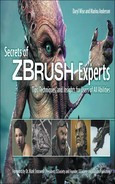
“The Little Monk.”
I was born in São Paulo, Brazil, in 1987. I’ve been a big fan of comics, movies, and games ever since I can remember. Nowadays, as a computer graphics (CG) artist, I see my dreams coming true. I’m passionate about anatomy, which for me is the main goal of any good work. So I always update my studies to grow as an artist. I’m currently employed as a freelance character artist at Tribbo Post, one of the biggest post-production companies in Brazil.
The base mesh creation is a simple and quick process. I care more about the structure and the polygon amount on each part than the shape. I need to think where I’m going to include more details and add more ZSpheres to it. I’m careful with weird polygons caused by ZSpheres approximation, because they can ruin the model’s symmetry on the next steps. See Figure 2.1.
I block the main shape of my character. I don’t care about the polygon count. Using the Move Brush or the new Move Brushes, I reshape my ZSpheres base mesh until I’m satisfied. In this step, I decide all the proportions—cartoony or realistic, human or creature. See Figure 2.2.
I block the body anatomy, sculpting the basic muscles and bone shapes. I do it in a simple form, with not too many polygons, just to visualize the body type of my character. The head and the hands have a lot more polygons than the body, because they are the most detailed parts of the model, and the rest will be covered by cloth.
I block the whole body anatomy, even if most of it will be covered by cloth. This way the clothing process becomes a lot easier. I never go too far with this initial anatomy blocking because after the pose I have to resculpt almost everything. In this case, I keep the T-posed model until the fourth subdivision level. See Figures 2.3 and 2.4.
I pose my models with Transpose or Transpose Master. This method is not perfect, so I resculpt most of the model here to adjust body distortions, muscle tensions, and so on. I don’t go 100% on the anatomy blocking because I don’t want to waste work. I search for pose references so I can keep the model’s pose realistically balanced. See Figure 2.5.
The last thing I pose in this character is the hands, because I depend on the staff position to do it. I first put the staff in the correct position, and then I adjust the arms and hands to actually grab it, also using Transpose.
After that I refine all the muscles and body shapes to fit the pose and its muscular tension. See Figure 2.6.
For this character, I create everything with ZBrush. The Mesh Extraction is a useful tool for this. I just have to mask where I want to put cloth and extract it, like the pants area (mask the legs) or the bracelets fabric (mask the forearm). After extracting the mesh, I inflate it a little bit and then sculpt it as a piece of fabric. I also use ZSpheres to model the “ropes” on the bracelets; then I flatten the surface to look like a fabric strip. With the same process, I create his black belt, the “kimono” suit, and his shoes. For sculpting cloth folds, I mostly use the Standard Brush with LazyMouse and the Slash 2 Brush. See Figures 2.7 and 2.8.
In this step, I review all the SubTools one by one and refine them, adding more folds on the cloth. With the Rope Brush, I detail the fabric strips on the forearm and legs; force the face expression a bit; add wrinkles, veins, and hair; and work more on the hands. I basically finish the model. I also add a bit of color on the SubTools to make them different from each other. See Figures 2.9 and 2.10.
To finish the model, I search for a few alphas on the Internet. Using the ShadowBox feature, I use the alpha in the Mask Brush to create my kung-fu support. No big deal. I just adjust the ShadowBox resolution to 800 instead of 128 (default) so I can get more details from my alpha and make it a polygon mesh. I also add a fabric texture to my cloth using a simple fabric alpha and add the same kung-fu symbol from the pedestal to his back.
In this case, my initial idea was to do a clay render. But now I start to test some render settings and want to put some color paint on the body. So with the Clay Brush (without Zadd), Color Spray, and a simple dots alpha, I Polypaint the model to create some color variations and make the model look a little bit more real. I don’t use ZAppLink or SpotLight to paint with photos because my intention is to create a cartoonish look.
I start to render, with the settings shown in Figure 2.13. For the composing, I take three renders in each position, and each render has a different light direction (main light, fill light, and backlight). After that, I compose the renders in Photoshop, make a few color corrections, and it’s done! See Figures 2.11, 2.12, and 2.13.
























